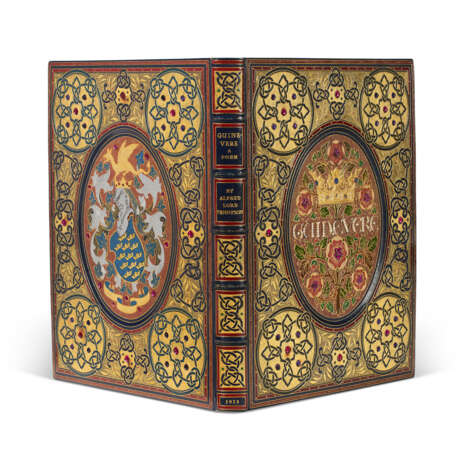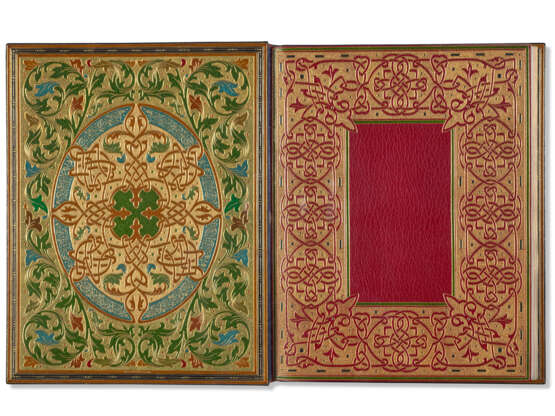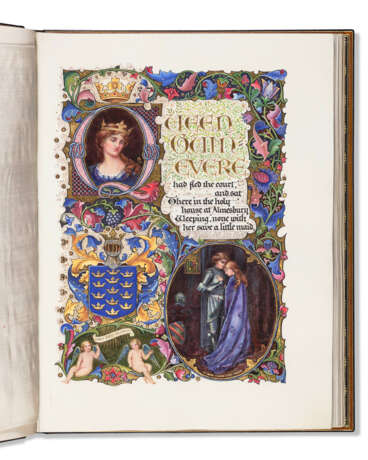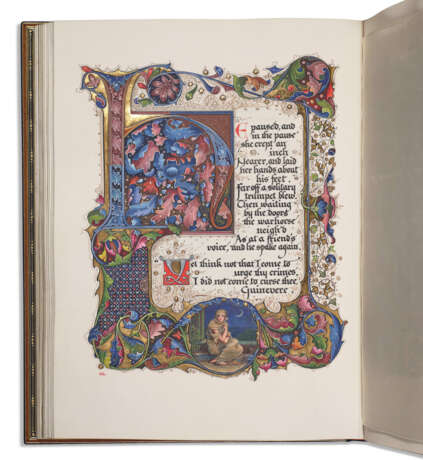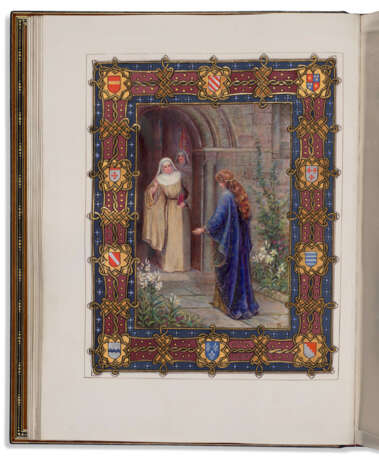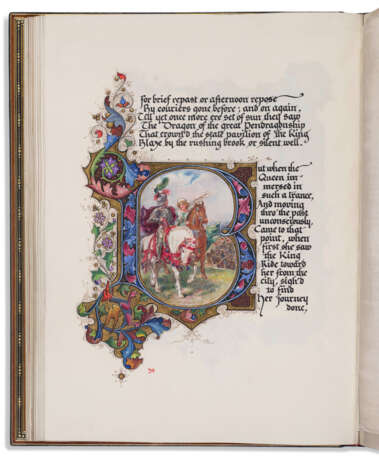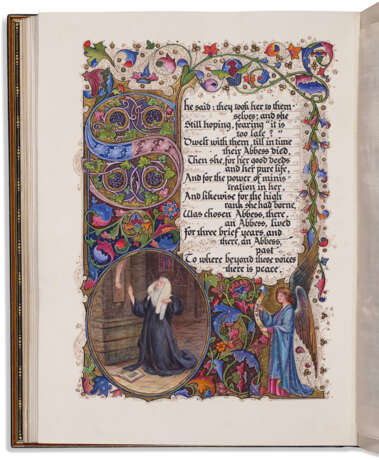ID 813766
Lot 61 | Guinevere by Alfred Lord Tennyson
Valeur estimée
$ 100 000 – 150 000
Alberto Sangorski for Riviere, 1913
SANGORSKI, Alberto (1862-1932), calligrapher and illuminator. RIVIERE & SON, binders. TENNYSON, Alfred Lord (1809-1892). “Guinevere. A Poem by Alfred Lord Tennyson.” London, [1909-] 1913.
GUINEVERE: A fitting successor to the Titanic Rubaiyat and a masterpiece of Alberto Sangorski’s art and calligraphy. In an exquisite jeweled binding by Rivière with sunken panels and full morocco doublures, encrusted with pearls, diamonds, rubies and other gems, richly inlaid morocco gilt, and gold and silver plaquettes.
A magnificent work, probably the finest jeweled binding on a modern illuminated manuscript ever accomplished. This volume is a complete work of art; it presents delights and surprises at the turn of every page and at every angle of the binding. Alberto Sangorski and his brother Francis, both illuminators and binding designers and originally partners, had a falling out in about 1910. Alberto took his skills to the binders Rivière. When the Titanic went down in April 1912, Francis Sangorski's lavishly jeweled binding on the Rubaiyat, the so-called "Great Omar" went with it, having just been purchased at auction. The publicity around the loss of this binding must have rankled Alberto as, after all, the exquisite binding was somewhat wasted on a not particularly distinguished printed book. A unique and beautiful manuscript such as the present Guinevere is much more appropriate.
Of the many magnificent modern jeweled bindings in the collection of Phoebe A.D. Boyle, the present one achieved the record price in her 1923 auction sale: $2000. (The Titanic Rubaiyat had sold for £405 in 1912 at Sotheby's.) According to the Boyle catalogue, the manuscript took over four years to accomplish. The calligraphed certification leaf at the end reads: “This manuscript … was designed, written out, and illuminated by Alberto Sangorski … London. 1913. This manuscript will not be duplicated,” and is signed by Sangorski. Literature: Examples of Modern Bookbinding designed and Executed by Robt. Rivière and Son. London: Quaritch, 1919. Illustrated with four plates.
Quarto (290 x 218mm). Illuminated manuscript on vellum, 34 leaves, plus three blank vellum leaves at both front and back, mounted on guards. Pictorial title in colors and gilt, with portrait of Tennyson in a central medallion surrounded by cherubs, a female nude, and a bat, title in gold with a border of acanthus leaves, fruits and flowers, in colors and gold; full-page frontispiece portrait of Guinevere at Almesbury, with “AS” cypher dated 1912 in an illuminated border of acanthus leaves, flowers, coats-of-arms, with gold and silver, incorporating two dragons and a miniature of nuns at mass; calligraphed text of the poem on pages [3]-58 in black and red inks, each page illuminated, usually with one or more decorated or pictorial initials; three additional full-page miniatures each signed with Sangorski’s cypher and similarly bordered; one half-page miniature; 11 further border miniatures or narrative initials for a TOTAL OF 17 MINIATURES; all richly illuminated in colors, gold, tooled gold, and silver; cream silk guards to the pages with miniatures.
Full crushed blue morocco jeweled binding by Rivière & Son, dark green morocco doublures, red morocco flyleaves, all edges gilt. The upper cover with sunken oval panel of red morocco enclosing the title “Guinevere” lettered in seed pearls set in gold, surmounted by a gold plaquette in the shape of a crown set with diamonds, seed pearls and three sapphires, the background depicts a rose bush with leaves in three shades of inlaid green morocco, the branches in to shades of brown, and six Tudor roses in cream and pink with six rubies set in gold; this oval panel surrounded by an intricate strapwork design of gilt-rules and gilt-stamped vines with red inlaid morocco berries, the ground richly worked with gold dots of various sizes; cornerpieces incorporating one garnet and four amethysts each, four additional rubies on sides; outer border of red morocco gilt inlay; strapwork panel and oval panel each additionally bordered with red morocco gilt inlay. The lower cover symmetrical with identical jeweled strapwork panel and red morocco inlay borders; the sunken oval panel on the lower panel depicts the crest of King Arthur: the mantling and helmet are silver plaquettes ruled in black, the plumes are silver plaquettes and black and light blue morocco ruled in gilt, the crown and dragon are gold plaquettes exquisitely tooled, as is the motto below, “Soli Deo Gloria;” the background is covered in gilt dots and with 11 rubies around the sides; there are three additional rubies set within the crown. Spine gilt in six compartments with raised and gilt bands, each compartment with red morocco inlay borders, two lettered in gilt, the rest with a gilt-ground strapwork design; board edges with double-gilt rule. Inner doublures are identical with a central oval panel of intricate strapwork on a fine pointillé background, incorporating green and blue morocco acanthus leaves, surrounded by a blue morocco border with gilt Le Gascon scrollwork; the oval surrounded by an acanthus leaf border on gilt dot background, with details in red, light brown, dark brown, and olive green morocco inlay; triple border of brown and navy morocco gilt. The upper and lower red levant morocco flyleaves are also identical with inner and outer green morocco borders, and wide frame of intricate strapwork on a gilt dot background, with navy morocco inlay lozenges and dots. (Some of the larger rubies with slightest discoloration and stress near settings, two very tiny rubs to lower board edge.) Full morocco box lined with silk and velvet.
Provenance: Phoebe A.D. Boyle (her sale, Anderson Galleries, 20 November 1923, lot 337 [to Gabriel Wells, 1861-1946] – anonymous owner (Parke-Bernet Galleries, 13 October 1970, lot 68) – Arnold and Miriam Elkind (their sale, Sotheby’s New York, 7 December 1994, lot 414).
| Adresse de l'enchère |
CHRISTIE'S 20 Rockefeller Plaza 10020 New York Etats-Unis | ||||||||||||||
|---|---|---|---|---|---|---|---|---|---|---|---|---|---|---|---|
| Aperçu |
| ||||||||||||||
| Téléphone | +1 212 636 2000 | ||||||||||||||
| Fax | +1 212 636 4930 | ||||||||||||||
| Conditions d'utilisation | Conditions d'utilisation | ||||||||||||||
| transport |
Service postal Service de messagerie ramassage par vous-même | ||||||||||||||
| Modes de paiement |
Virement bancaire | ||||||||||||||
| Heures d'ouverture | Heures d'ouverture
|
